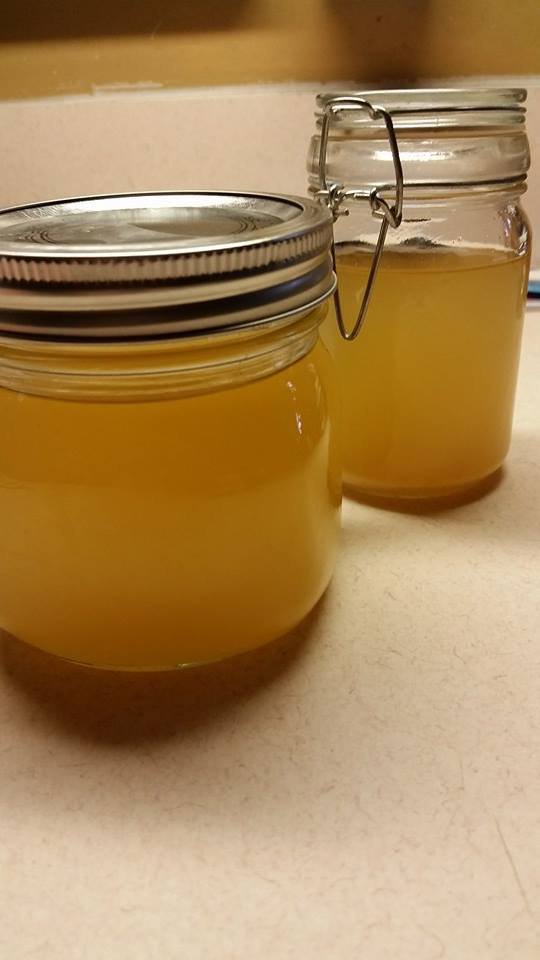
Brian McMahan
lovely, fresh lard
When I was a kid wolfing down my great-grandma's fried chicken I didn't know lard was a four-letter word. I just knew the piping hot, crunchy chicken she turned out of her Manchester kitchen was pretty much perfect. She's been gone many years now, that 85-pound spitfire who would chase us kids out of her back yard chicken coop. Those chickens -- after she wrung their necks and fried them up in lard -- are among my most enduring food memories.
I went through some years, with many other Americans, thinking lard was bad for you, a guilty pleasure at best, before coming back around to the joys of rendered pork fat. A farmer friend would sell it to me by the bucket and it made its way into fried potatoes, fried chicken, and any number of goodies in my own kitchen. Then I lost my source when he retired from farming, and, since I don't want to buy lard from commercially raised pigs, I thought my lovely lard days were over.
Tucking into a most amazing pie recently at a Cochon Heritage BBQ event, my interest in the wonder ingredient was renewed. Feast BBQ served up a savory pie of pork and beans, encased in a crust that shattered into layers of warm, porky goodness with each bite. As a judge at the event, I needed to restrain myself but I couldn't tear myself away from that pie. The filling was delicious, of course, but it was that made-with-lard crust that propelled it over the top.
I later begged the recipe from Feast owner Ryan Rogers, but laughed out loud when I received it from him. I may be a more ambitious than average home cook, but his two-day feat of kitchen prowess is well beyond my abilities. (At least he was honest, noting halfway through the 1200-word set of instructions that 'by this point you hate this dish'.) The recipe for the crust, though, which he provided courtesy of his pastry chef Margaret Lawrence, looks doable for an enthusiast. But first, I needed lard.
Over conversation with friends, fellow food lovers who own Grind Burger Kitchen, I mentioned the huge chunk of pork trim I had sitting in my fridge, a gift from the farmer who used to provide my lard. I'd intended to cure it for lardo but never got around to it. "You can make lard," they said. It was a slap-my-forehead moment. Of course!
So the next weekend, while I was away in Detroit with a friend, my husband embarked on a lard-making project, keeping me updated by texting photos throughout the process. It looked remarkably simple. He cubed the pork trim into two-inch sections, simmered it in the slow-cooker on high with a cup of water for about five hours, then strained it through a colander with a thin dish towel. And look! We had lard.
It's in my fridge now, tempting me with visions of fried chicken. But I think I have to make that pie crust. I haven't decided what kind of savory filling to put in it. For the love of lard, do tell me if you have ideas.
Butter-Lard Pie Crust
( courtesy of Margaret Lawrence of Feast BBQ)
Yield: 2-9 inch pies or a top and bottom crust for a double-crust pie.
2.5 c. all-purpose flour
1 t. salt
1 T. sugar
5 oz. cold butter, cut into 1-in. pieces
5 oz. cold pork lard, cut into 1-in. pieces
1 T. apple cider vinegar
5-7 T. ice water
Process:
1. Place butter and lard pieces into freezer before beginning to ensure that they stay cold throughout mixing.
2. Combine flour, salt, and sugar in the bowl of a food processor. Pulse 3-5 times to mix evenly.
3. Add the cold butter and lard and pulse until the pieces are about the size of peas and the mixture resembles coarse cornmeal.
4. Mix the vinegar into the smallest amount of water called for, and slowly pour in through the feeding tube as you pulse the mixture. Stop when the dough just begins to come together. Add remaining water only if mixture looks very dry and does not hold together when pressed. It should look slightly crumbly.
